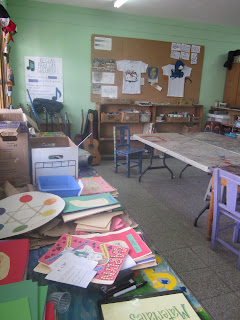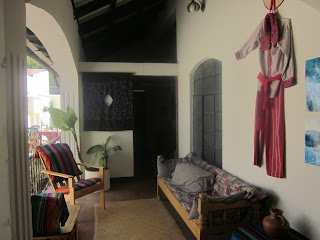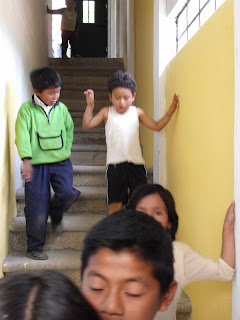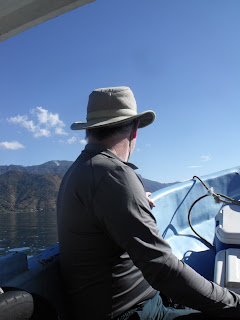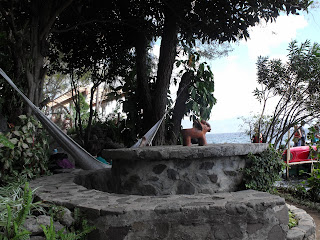Another drive on the yellow school bus into Guatemala City, a brief stop at Safe Passage and then on to the Guarderia.
I feel like a deer caught in the headlights. How should I be feeling? I suppose I imagined myself playing with kids and "making happy". I want this to happen. Still, as hard as I try to force it, my smiles just won't come.
I am stunned. The reality of Guatemala City and the dump situation numbs me from the inside out. At times I feel frozen. So many emotions. So many thoughts. My body has trouble correlating and tabulating and moving in unison with them. The very thought of not thinking about it all exhausts me.
I can't cry. That "dumb-smile" overtakes me. (If you are reading this and you were there with me on this day then maybe you know what I mean...because you saw me wearing it...you saw me retreating to my safe place in my mind, scribbling words and words and more words in my tiny gold-laced silk journal).
Safe Passage is a natural response to an unnatural situation. Decades of violence and human rights abuses have created this chaos. Nobel Peace Prize winner (1992) Rigoberta Menchu drew international attention to the government-sponsored genocide of Guatemala's indigenous people during a Civil War that killed over 200,000 Mayans. Estimates are that over 450 Mayan villages were destroyed and over one million people were displaced or became refugees.
Today, in a population of about 13 million people, 56.2% live in poverty!
The average age in Gauatemala is 19.4 years old (18.9 for males and 20 for females). Low life expectency is believed to be the result of disease, malnutrition, underdevelopment and minimal formal education.
"The problems of my people are many," is the phrase I play over and over in my mind. Gracelda was right. She was soooo pathetically right.
Although it hardly seems so, the children before me are among the lucky ones. They are the first generation in generations to give hope for a better future. A decade earlier they would have merely existed, with the pitiful "untouchable" logo engraved forever across their foreheads, been warn down and kicked about by it.
There is something else that bothers me today. It is me. And others like me. We slip in gasping predictably, believing our own shock and awe. We are the "Camera People". My lens starts to feel invasive. If I were one of these children I would tell me to put my money where my lens is.
This community, huddled under slices of jagged tin, needs solutions. But not my solutions. What they really need is power; a power that will enable their own unique strength, ingenuity and imagination to flourish.
Of course, our presence here, our photos, our stories, our very emotions go far in delivering what is needed. Becuase when we bring all these things back with us and share them with others we create awareness. Others knowing what goes on is vital when change requires money to get the ball rolling.
Still, I don't take as many photos as I really want to. For much of the day I put my camera away. I use my other tools. My curiousity. My netbook. My journal.
I work in the 3 year old room today. We head to our posts just before 9 am; behind gates, monitored by guards. Once we get to where we are going it is a different world. These classrooms could easily be transplanted to any Canadian preschool. Sand box. Water play. Wash-the-baby station. I join the singing circle and observe the young Guatemalan teacher ans her lively attempt to engage the children.
At least half of the students are absent. I learn later that this is because there is some sort of government food give-away happening. The parents have gone to get food rather than work in the dump and they have taken their kids with them. I imagine this is because if they are late picking up at the end of the day the child will not be accepted the the followng day. It seems harsh under these circumstances. But on further observation it really isn't. It helps the parents learn responsibility and the value of time...their time, volunteer time and the teacher's time.
The children in the circle are quiet. They aren't what my experience tell me is "typical". Certainly not the pampered rambunctious kids I am use to seeing. There is only one boy in the group. He seems tired. I wonder about his age. Mostly he sits intolerably still.
Breakfast is a roll with bean paste (Man, Guatemalan's love their rolls!), and a milky-looking drink (not milk) that I can't identify. An hour or so later the teacher delivers a bowl with jello and suspended banana to each child. They go outside after snack and I wash the bowls and cutlery.
This is where things get sticky. In Guatemala there is no hot running water in sinks (or so has been my limited experience). And definitely no dishwashers. (Just getting warm water in the shower is a luxury. I know I harp on this. As it turns out I really am a spoiled westerner and I HATE taking a cold shower. I whimper at the mere thought.) So, I rince off the dishes with polluted. bacteria-laden water. And I place them on the tray wet, feeling somewhat guilty as Ideliver them to the kitchen. I'm not being tailed by the health department. I watch as the amiable kitchen staff place them back on the shelf for use during lunch.
Today I feel brave. Maybe I feel strong in body, certainly not in mind. So I eat the lunch provided. It is the one an only time I do this. The others tell me it is "safe". I've taken the last of my cipro antibiotic so I sure hope it is so.
Lunch? Mystery meat (perhaps bologna) drenched in a spice-free tomato sauce, mashed potatos and a salad swimming in a runny white dressing. "Never ever ever eat lettuce in Guatemala." Tom's warning rings in my ears. I eat the tortilla. I eat some meat. I try a spoonful of potato. And I pray that I don't succumb to another runny gastro-intestinal disaster.
Sarah has been assigned to create a bulliten board demonstrating colour and counting. She dives in, making a plan, cutting out shapes and affixing them to a wall board in the comon area. At one pooint I offer to help. I sit at the child-sized table and outline parts of a flower. It's a meagre contribution.
After lunch Sarah and I interview Susana, the founder of Oneness and the creator of the Planting Seeds ECE program. Susana easily admits to not being comfortable on camera. However, she is passionate about her topic so I manage to quite easily take her mind off the invasive lens. I have no shortage of questions. We both concentrate. Sarah moves around us with her camera. It takes 40 minutes.
I am inspired by the video. I take my camera, switch on the video and film an English lesson in the common area. Julia Byers of Seattle impressed me yet again. Wow! She is a born teacher. She sings. She engages them in a language they need to learn but only hear while in this place. She is firm. She is compassionate. I watch. Visitors from a Rotary Club in Maine watch. Marg and Sarah and Susana watch. Julia is undaunted. Her role is to be with the children and that is what she focuses on. And man-oh-man she does her job well!
Congratulations Julia from Seattle, these children are fortunate to learn from you!
Afterwards, I meet Comino Seguro's Volunteer Coordinator, Madeline; another youthful American wise beyond her years. I talk to her about my concerns and fears and general thoughts. She listens. I ask her to talk me on a tour of the dump environs. I am particularly interested in the Adult Literacy Program and actually seeing the "dump".
Monday morning at 9am I will get a tour. Hopefully this will help me better digest where I am and why...
The bus leaves for "home" at 4:15 pm. All I can think about is dinner. We have reservations at a Guatemalan restaurant owned by a couple from Texas. The prmoise of live ethnic music makes me smile. I think I will get dressed up;have a shower, throw on the burgandy skirt I bought at the Chi Chi Market with my lilac shawl and comb my hair. This is Sarah's last night in Guatemala. I can hardly believe that three weeks are over, gone, vanished. But we have accomplished so much. I am so grateful for every moment.
It takes us well over an hour to get out of Guatemala City. Dinner is at 7:30. Damn, I am so hungry...


